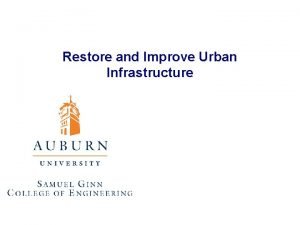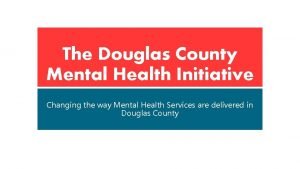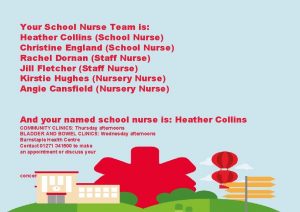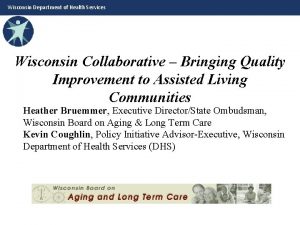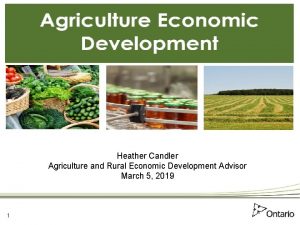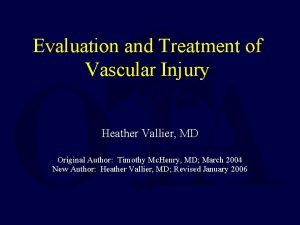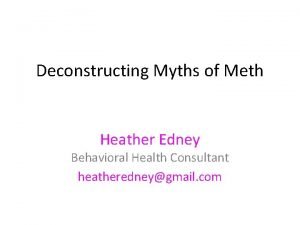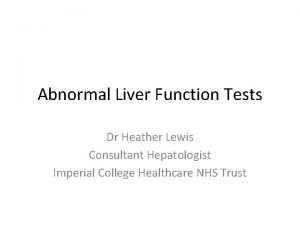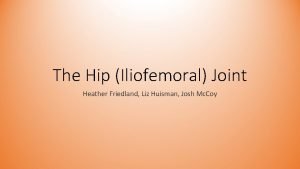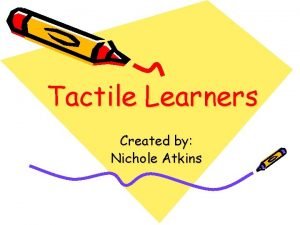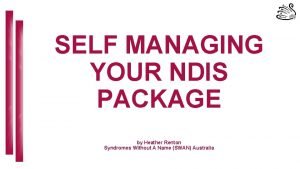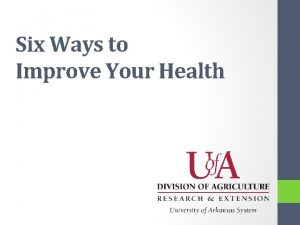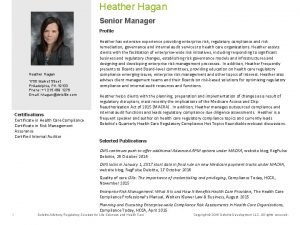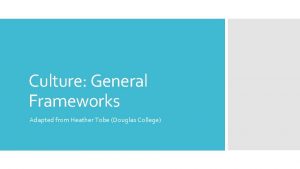Alternative ways to improve health Dr Heather Douglas



























- Slides: 27

Alternative ways to improve health Dr Heather Douglas Centre for Social Responsibility in Mining University of Queensland h. douglas@uq. edu. au or hdouglas 21@gmail. com

Health – just one aspect of wellbeing Wellbeing – a multidimensional condition with personal, social, environmental and economic features providing the foundation for individuals to live a dignified, meaningful life (Mc. Gregor, 2010).

Wellbeing - sufficient access to Basic requirements Health Education Personal safety Shelter Social welfare Income, material goods Meaningful life Employment, valued activities Social relationships Inclusion Personal accomplishments Natural environment Culture and heritage Stephen Hawking

Queensland budget: $55. 7 bn 201718 �Health 29. 5% �Education 24. 2% �Social welfare/housing/other community services 12. 8% �Transport & Communications 10. 3% �Public order & safety 9. 2% �Economic services 4. 2% �Other 9. 8%

Queensland budget: $55. 7 bn 2017 -18 Basic requirements % Health Education Personal safety 29. 4 Meaningful life 24. 5 Public 9. 2 order, safety Social welfare, community services, housing (Child safety, disability, communities 38. 7%) Shelter (Housing 17%) Income Economic services 4. 2% income ? ? % 12. 8 Employment/valued activities Social relationships Inclusion Personal accomplishments Natural environment Culture and heritage

Improving health: income & education �“Approximately 90% of variation in infant mortality can be explained by a country's per capita income, the distribution of income, the extent of women's education, the level of ethnic fragmentation, and the predominant religion. �Public spending on health has relatively little impact”. Filmer & Pritchett, World bank report, 1997

Improving health: investing in education

Improving health: Investing in education

Improving health: education �“Education has the potential to bring significant benefits to individuals and society, which go well beyond its contribution to individuals’ employability or income”.

OECD: Education benefits �Education improves agency: it enables individuals to �perform better in the economy as employees or entrepreneurs �improves wellbeing, civic engagement, longevity, happiness, health �individuals are more able to make decisions and contain violence. �“By fully recognising the power of education, policy makers could better address diverse societal challenges”. OECD 2013 EDUCATION INDICATORS FOCUS 01

Improving health in disadvantaged populations: educating girls and women �There is a strong link between educating girls and positive outcomes for the health, economic empowerment and social improvement (OECD). �Educating girls helps to make all communities and societies healthier, wealthier and safer (World Bank, 2014). �These effects apply in developing countries and also disadvantaged communities in developed economies.

Improving health: educating girls �Educating girls is one of the most important investments for the future of developing countries �Better educated women tend to be healthier, participate more in formal labour markets, marry later, have fewer children �Investing in girls’ primary education has a significant impact on their agency, reducing violence and family size, increasing control over material assets, and increased capacity to engage in economic activities �The lifetime economic return for one year of a girl’s secondary education is an increase of up to 25% �These effects carry from one generation to the next. (World Bank 2014)

Educating women & girls: benefits For women For families For communities 10% increase in female earnings for each year of schooling A child of a literate mother is 50% more likely to live past 5 years of age 25% increase in agricultural output in Sub. Saharan Africa Children of mothers 35% higher GDP Girls with secondary per capita for education have schooling are 6 better nutrition and each additional times less likely brain development year of Adapted from Global Partnership for Education 2016; Somani to be child brides education 2017

Linking education and health https: //societyhealth. vcu. edu/work/the-projects/why-education-matters-to-health-exploring-the-causes. html

Improving health: income �Children from poor families do not perform as well at school as those of affluent families, and �Rich people have better health than poor people, �So we need to examine income

Why do better educated, richer people live longer and in better health than poorer, less well educated people?

Improving health: income �Income provides options – to buy services, relocate to better neighbourhoods, eat better, have better housing etc. �All of these affect health and wellbeing

Improving health: income �Mortality is positively and significantly correlated with almost all measures of income inequality �Life expectancy widened in many countries after 1980 as income inequality was increasing (NBER report, 2003)

Australia ACOSS https: //www. acoss. org. au/inequality/

Relative income across Australia

Proportion of people at income levels

Improving health: Income arguments �Materialist arguments e. g. money buys health- promoting goods and the ability to engage in a social life in ways that enable people to be healthy; �Psychosocial mechanisms e. g. the stress of not having enough �money may affect health; �Behavioural factors – people living in disadvantaged circumstances are more likely to have unhealthy behaviours; �Circular effects - poor health affects education and employment opportunities and these

Improving health: income �ABS – approximately 40% of the Australian working population has non traditional working arrangements �Part time work �Short term contracts e. g. 1 month – 1 year �Non standard hours �Precarious work (0 hour contracts, infrequent work) �Gig economy

Improving health: income �Long term unemployed 22. 9% June 2016 cf 12. 8% 2009 � 41% of unemployed 55 -64 yr olds were long term � 2016 employment grew 212, 000 but 68. 3% was PT �PT work grown 26% (June 2000) to 32% (June 2016) �Precarious work arrangements are difficult to document but � 50% of academic employment is non traditional working arrangements, especially tutors and research staff

Improving health: income �Nonstandard work = reduced income �Reserve bank is increasingly discussing these effects as ‘low wage growth’

So what? �We need to consider health as only one aspect of wellbeing �Need to consider budgeting adequately to offer people meaningful lives

Consider wellbeing in budget process Fund and measure what matters
 Difference between spirituality and religion
Difference between spirituality and religion Ways to improve urban infrastructure
Ways to improve urban infrastructure Underutilization on a graph
Underutilization on a graph Romans 3:10
Romans 3:10 Douglas county mental health initiative
Douglas county mental health initiative Protect, promote, and improve the health of all people
Protect, promote, and improve the health of all people Dr heather collins
Dr heather collins Heather bruemmer wisconsin
Heather bruemmer wisconsin Heather youngquist
Heather youngquist Perceptual reasoning
Perceptual reasoning Heather lott
Heather lott Heather briston
Heather briston Montgomery township school district
Montgomery township school district Heather birge
Heather birge Heather jurek
Heather jurek Keechi creek wma
Keechi creek wma Heather hansen
Heather hansen Agriculture
Agriculture Heather vallier md
Heather vallier md Heather edney
Heather edney Dr. heather lewis
Dr. heather lewis Dr. heather lewis
Dr. heather lewis Liz friedland
Liz friedland Facts about tactile learners
Facts about tactile learners Odbudsman
Odbudsman Heather richter lipford
Heather richter lipford Heather blackwood
Heather blackwood Heather must prove this theorem
Heather must prove this theorem

